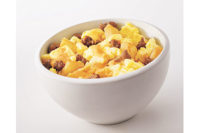Meat is an increasingly prominent breakfast element.
While the traditional eggs and starches such as pancakes and waffles remain popular, more consumers are making meats key meal components as they seek options that are healthy, novel, tasty and convenient.
It results in the inclusion of meat selections in more foodservice menus and greater sales of the breakfast proteins in both restaurants and supermarkets.
While volume sales of such traditional breakfast foods as ready-to-eat cereal, toaster pastries and frozen waffles have decreased 4 percent, 5.5 percent and 1.3 percent, respectively, over the last year, supermarket breakfast-meat revenues are increasing in all major segments, reports Nielsen Perishables Group, a Chicago-based fresh foods consulting and research firm.
Revenues for bacon, the most popular breakfast protein, are up more than 12 percent for the 52 weeks ending July 26. Increasing shopper focus on health and wellness is helping to fuel such activity. Volume sales of organic, natural and low-fat fresh UPC-coded pork bacon grew 26 percent, 28 percent and 16.8 percent, respectively, over the last year.
In addition, volume sales of chicken sausage increased 31.5 percent, with organic chicken sausage up 60.8 percent and natural growing 40.3 percent. Volume sales of fresh UPC-coded turkey sausage, meanwhile, grew 24.5 percent, with low-fat turkey up 63.2 percent and reduced fat turkey increasing 71.6 percent.
More consumers also are embracing handheld foods as they seek more convenient options.
The power of portability
Harry Balzer, chief industry analyst for The NPD Group Inc., a Port Washington, N.Y.-based consumer market research firm, says the growth of breakfast sandwiches — which often include meat — is having a major impact on breakfast activity.
While the bulk of breakfast sandwich purchases occur at foodservice locations, frozen items also are becoming more prominent in supermarket cases.
“Breakfast sandwiches are making it into the house as Americans are always looking for a hearty breakfast while balancing the need for convenience,” he says. “Both meat and eggs are getting into more breakfasts through the sandwich.”
Balzer notes that sandwiches are the top breakfast item purchased from foodservice outlets and sales are gradually increasing at supermarkets. Sandwiches account for 4.3 percent of in-home breakfasts, up from 1.1 percent in 1984.
Close to 47 percent of all restaurant breakfast selections, meanwhile, consist of a sandwich, compared with 22.7 percent in 1989, he reports.
“The sandwich is the story,” Balzer says. “The typical 1955 meal of bacon, eggs and toast is now being put into a handheld product, which could be a muffin or bagel. We didn’t let go of the basic breakfast. Sandwiches have made it easier to eat what we love.”
Nielsen Perishables Group, meanwhile, reports that dollar and volume sales for frozen breakfast sandwiches are up 10 percent and 9 percent, respectively, over the last year, while deli dollar sales grew 14 percent with volume up 4 percent. Sausage is the most popular frozen breakfast sandwich, with a 7 percent growth in dollar sales and a 6 percent increase in volume.
“Consumers are moving away from traditional breakfast categories to more protein and filling options,” says Sarah Schmansky, Nielsen Perishables Group director of account services. “With consumers working more hours, delaying families and wanting convenient meal solutions, on-the-go handheld options are becoming increasingly popular.”
Branching out
Breakfast proteins, meanwhile, are becoming more prominent in different areas of supermarkets, including the meat, specialty meat and deli departments. The specialty meats sector was named by 29 percent of consumers as a good source for something quick to prepare or eat for breakfast, reports the Madison, Wis.-based International Dairy-Deli-Bakery Association (IDDBA).
Specialty meats ranked higher than the specialty cheese (20 percent) and deli (18 percent) departments as a good source for something quick to prepare or eat for breakfast in the IDDBA survey, but trailed the bakery (36 percent).
“This seems to indicate that the idea of deli proteins for breakfast is not foreign, but that dairy case and bakery department offerings may be easier to deal with for immediate consumption,” says Alan Hiebert, IDDBA senior research director.
He says breakfast proteins, including meats, are becoming more popular as Millennials — people born between the early 1980s and early 2000s — take a more active role in meal preparation.
IDDBA research reveals that Millennials are more likely to think of the deli as a source for breakfast than their parents.
Nielsen Perishables Group reports dollar sales of deli bacon grew 58 percent over the last year, with volume up 16 percent. In contrast, dollar and volume sales of frozen bacon grew 26 percent and 17 percent, respectively, while refrigerated bacon had an 11 percent increase in dollar sales and a 0.1 percent decline in volume sales.
Meanwhile, 21 percent of Millennials reported they thought the deli would be a good place to pick up something quick to prepare or eat for breakfast, compared with 18 percent of all respondents and 15 percent of Baby Boomers.
“While the deli scores significantly better for lunch options, younger consumers appear to be open to deli products for breakfast,” Hiebert says.
And many are seeking healthier meats. Hiebert notes Millennials are especially attentive to ingredients lacking preservatives and boosting flavor while supporting grass-fed, local or organic features.
“As prices go up, many are seeking quality over quantity,” he says. “IDDBA research has found that consumers are more health conscious earlier in the day, so it would stand that health-oriented deli proteins would be more popular at breakfast.”
As a result, retailers “are trying to offer more healthy meat options, like chicken or turkey, instead of the more traditional sausage or bacon,” Hiebert adds.
Creating a health halo
Kari Underly, president of Range Inc., a Chicago-based meat marketing, training and education firm, agrees that demand is increasing for healthier breakfast meals.
“More people are opposed to the nitrates in bacon and sausage, so we’re seeing more house-made items with cleaner labels,” she says. “Breakfast meats, however, still have a smaller ring for supermarkets, so the challenge is getting the products in front of consumers.”
In fact, the growing popularity of yogurt is making it more difficult for breakfast meats to garner a greater share of breakfast revenues.
The Nielsen Perishables Group reports yogurt was a $4.2 billion industry in 2013, with 49 percent of consumers regularly starting the day with yogurt. One-third of the market is Greek-style yogurt.
“Many consumers are going to a non-meat protein like yogurt for breakfast,” Schmansky says. “Consumers are more health conscious and they want to put protein in their diet. They also understand that proteins can be indulgent. They are not shying away from it, but many are looking at the calorie and fat content.”
With large walls of yogurt making the proteins highly visible and accessible in supermarkets, Underly says it is key for breakfast meats to also be noticeable to shoppers and marketed as an attractive alternative to yogurt.
“If shoppers are interested in handheld foods, such as yogurt, there also needs to be a handheld retail meat application that could contain chicken or lamb,” she says.
Possible marketing vehicles, she adds, can include breakfast bunkers, in-store promotions and advertising. “Grocers also might situate beef jerky next to boiled eggs or smoked salmon in front of the items,” she says.
Other ways to spur interest in breakfast meats include offering in-house smoked bacon and sausage and expanding the fresh sausage options in meat departments, Underly says.
Whole Foods is among the retailers already emphasizing fresh breakfast meats. The full-service meat case at a suburban Chicago outlet, for instance, features six varieties of store-made pork bacon: maple, original smokehouse, apple cinnamon, Black Forest dry rub, jalapeno and curry.
The nine fresh sausage options include pork breakfast, turkey Italian and chicken Italian. A Whole Foods associate says the bacon and sausage are made fresh daily on-site and unsold items are discarded after 24 hours.
“Fresh sausage is a high-profit item and the whole sausage category is likely to grow,” Underly says. “Supermarkets that smoke bacon or sausage in-house can also add the items to the deli and have cross-promotions.”
A stubborn sector
More challenging is the merchandising of beef for breakfast, Underly says. She notes it has been difficult getting retailers to prepare breakfast-oriented beef as many do not want to devote the labor to developing items for which there is little demand, such as beef bacon.
One product attempting to break that barrier, however, is Schmacon — a product launched this spring that was the talk of the National Restaurant Association’s annual show in Chicago and won an innovation award at the show as well. It is still too early to tell if Schmacon (which is not beef bacon, but is categorized as “smoked and cured glazed beef slices”) will make a truly significant impact for beef in this sector, but the company behind the product, Schmaltz Products LLC, has put significant energy into the effort.
More breakfast beef activity, however, is occurring at foodservice locations. The Centennial, Colo.-based National Cattlemen’s Beef Association (NCBA) notes that over the last two years, the number of beef breakfast items on menus has grown 300 percent and the amount of operators offering beef for breakfast has increased 400 percent.
Such items include breakfast sandwiches and wraps, beef sausage and pastrami.
Nevertheless, Alison Krebs, NCBA director of market intelligence, says a base of shoppers still is seeking in-home beef options. She says the most prevalent searches for breakfast recipes on the NCBA’s beefitswhatsfordinner.com Web site include Baja Sunrise Steak and Eggs, Beef Sticky Buns, Beef Breakfast Burrito and Beef Sweet Potato Hash.
Krebs adds that some retailers are looking to keep pace with foodservice outlets by including more breakfast meats in their prepared food options.
“Stores with a prepared foods department — or in-store restaurant, or ‘groceraunt’ — are looking to breakfast as a new opportunity to compete with foodservice and attract morning traffic to their stores” she says.
The suburban Chicago Whole Foods, for example, operates a hot breakfast buffet from 8 a.m. to 10 a.m. that includes turkey sausage, bacon and items with meat options as pizza, burritos and tacos.
“Retailers know that consumers are focused on protein and they are bringing in a variety of meats, including organic and natural, to win a variety of customers,” Schmansky says.
The merchandising of breakfast proteins is creating large revenue opportunities for both supermarket and foodservice operators. Merchandisers that respond to the specific demands of their customer bases — including consumers seeking heath, convenience and flavorful options — will be well-positioned to prosper.
READ MORE on breakfast meats here.





Report Abusive Comment